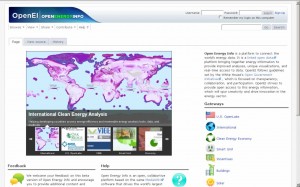With solar, wind, PHEVs, geothermal, biofuels and most other green technologies still out of reach for most people, the U.S. Department of Energy wants to try crowdsourcing our way to affordable clean energy.
 The DOE recently launched an open-source wiki called Open Energy Information (OpenIE.org) as a community platform for collectively solving our energy challenges. What Wikipedia did for socializing world knowledge, OpenIE.org can do for clean technology innovation, the thinking goes.
The DOE recently launched an open-source wiki called Open Energy Information (OpenIE.org) as a community platform for collectively solving our energy challenges. What Wikipedia did for socializing world knowledge, OpenIE.org can do for clean technology innovation, the thinking goes.
“The true potential of this tool will grow with the public’s participation — as they add new data and share their expertise — to ensure that all communities have access to the information they need to broadly deploy the clean energy resources of the future,” said Secretary of Energy Steven Chu in the Agency’s press release.
OpenIE.org bills itself as a linked open data platform, trying to create synapses between all the world’s energy information “to provide improved analyses, unique visualizations, and real-time access to data.” Anyone can post and edit information, upload additional data to the site and download information in easy-to-use formats.
The site currently houses more than 60 clean energy resources and data sets, including maps of worldwide solar and wind potential, information on climate zones, and best practices. To give it even more social cred, OpenIE.org links to the DOE’s Virtual Information Bridge to Energy (VIBE), a browseable collection of widgets that provide up-to-date industry information and unique visualizations of clean energy data.
It’s a compelling idea. Most cleantech science is forged within silos, isolated in commercial and academic research labs. A global hive mind of expertise could bring a Red Bull jolt of collective creativity to unstick long-stuck science problems.
But will the labs be willing to play ball on an open source field if meant opening up their IP to competitors?